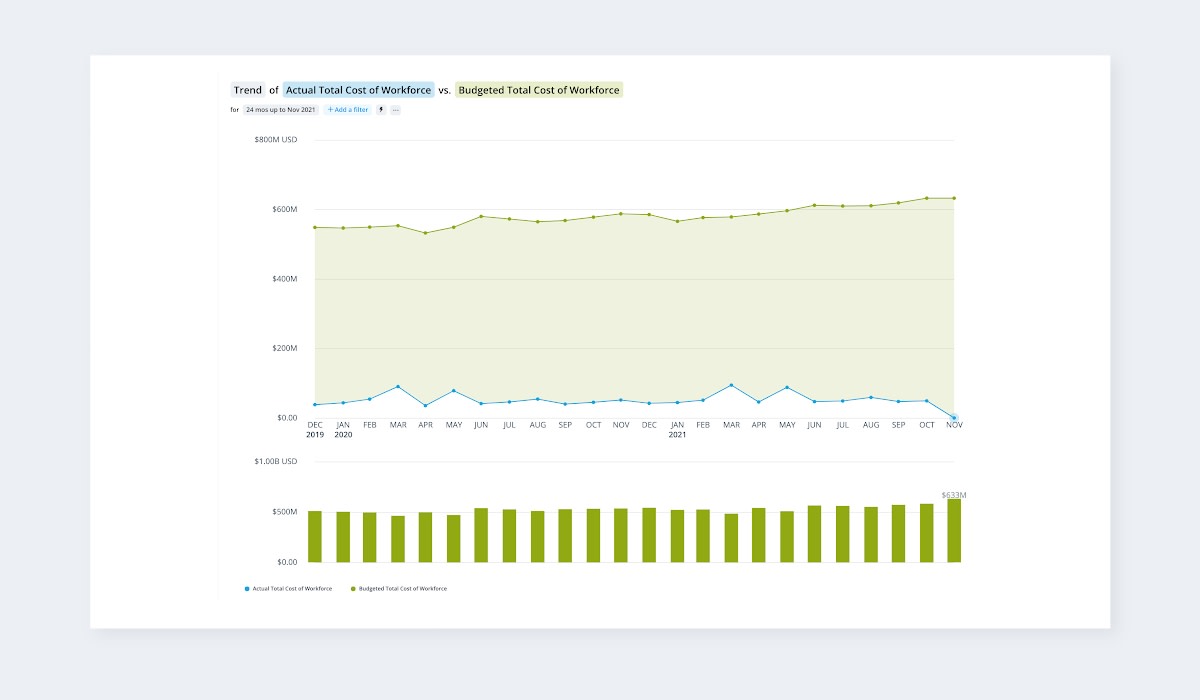10 Must-Have Manager Effectiveness Metrics
Take a look at ten key metrics for manager effectiveness that will help your organization motivate talents and reduce high-performer resignation rate.

The role of frontline managers has changed dramatically over the past few years. From pandemic-driven changes in where work happens to the continuous evolution of how work gets done with emerging technologies like generative AI (GAI), managers are consistently asked to meet change head-on. In the tech industry, in particular, competitive threats loom large. With the exponential increase in processing power, the race to “be first” has become increasingly daunting. Behind the scenes, competitors are continually working on new advances that may offer performance or cost advantages.
But staying ahead of the competition need not be a thankless, grueling task. There is a way to encourage your high performers to go above and beyond, while energizing them at the same time—it starts with tracking manager effectiveness metrics.

Measuring manager effectiveness to drive engagement and top performance
Managers play a crucial role in the dynamics of employee engagement and retention—a big part of the impetus for fostering a culture of effective leadership. The role of a manager is pivotal to business success. Managers who hire well and develop and retain top talent through their ability to lead, motivate, and empower their teams will directly impact the achievement of strategic objectives and business outcomes. In addition, today’s managers must be able to effectively leverage AI tools to positively impact productivity, strategic objectives, and business outcomes.
To achieve this, your people need strong guidance and development: A high challenge level but low skill level will produce anxiety, while a high challenge level and high skill level is likely to produce flow.
Aside from learning and development programs, you need managers who help people succeed and can coach them through stretch projects—key to innovation and staying ahead of the competition. In the long run, this is not just good for engagement, but also for retention. The old adage is true: “people quit their bosses, not their jobs.” And, conversely, people tend to stay with people who help them improve their skills.
So, it’s important to use effectiveness metrics that will help you answer questions like:
Which managers retain the most top performers?
Which managers grow the best employees?
Which managers drive the greatest levels of productivity?
From there, you can look to groom more managers like them, have conversations with those who need improvement, and make sure your best managers are managing your most critical teams.

10 must-have manager effectiveness metrics to stay ahead of the competition
1. Manager engagement score
Employee engagement is a critical element of high team performance. Gallup reports that employee engagement scores are bouncing back from an 11-year low in early 2024, rising from 30-32% this year. Although still not reaching the high of 36% seen in 2020, it’s an improvement. Managers have a significant impact on employee engagement.
Why you need to track it:
A manager who drives people to hit objectives without consideration for the team’s general well-being will only make employee burnout problems worse. In contrast, manager-coaches who take the time to ask people about their needs (and then respond appropriately) can help people gain a sense of control over their work lives and promote employee well-being.
Supervisors are the key link between the organization and the employee. They are not the only factor influencing employee engagement, however they are pivotal because of their opportunity to understand and support employee engagement at an individual level. Most engagement survey processes have a specific series of questions that look at how employees view their supervisor. Understanding and using this score to build a complete view of manager effectiveness is important.
How to get it:
The most common way to determine a manager’s engagement score is to calculate the mean scores for a series of survey items related to the supervisor relationship.
Red flags to act on:
When a manager’s engagement score is significantly lower than similar work groups in the organization, this is an indication that the manager is falling short. Analyzing this score alongside high performer turnover or absence rates will give you a good idea of how big an impact the manager is having on the team.
Low engagement coupled with high resignation and/or high absence rates means that action is required to improve the dynamics of that work group. It’s also worth doing some investigation based solely on low engagement, as this may be the first sign that resignations and absences will follow.
2. High performer resignation rate
Resignation and turnover are rarely desirable in organizations. But that’s especially true when those resignations occur among high performers. The good news: according to The Adecco Group, 83% of employees plan to stay with their employers this year. Still, talent retention must remain a high priority for competitive employers.
Why you need to track it:
A general turnover metric—which also incorporates the turnover of poor-performing employees—is too broad to support quality decisions about good management skills. Instead, examine the resignation rate of high performers to see if specific managers or work units are losing more high performers than others.
Strong, capable managers who view employees as assets can help organizations manage retention issues like turnover contagion by encouraging high-performing employees to stay with the organization for longer.
How to get it:
Choose a time frame (e.g. previous 12 months).
Count all the high-performing employees who resigned.
Calculate the average headcount for high-performing employees.
Divide the number of high performers who resigned by the average high performer headcount.
Note: If your organization is experiencing a labor shortage, you might be concerned about retaining people who are solid performers, too. In this case, you can also incorporate the turnover patterns of good performers in the analysis.

Red flags to act on:
Whenever the high-performer resignation rate is greater than the overall resignation rate, it signals a problem that needs to be addressed. If you’re losing high performers more quickly than your general employee base, this means your overall talent quality is reducing, which is likely to lead to productivity and quality challenges some time in the future.
If the rates for certain managers are substantially higher than other managers, this is an indication that all is not well in that work group. Although it would be too simplistic to assume the manager is the sole cause, it is an indicator that further investigation and insight is needed.

3. Employee experience
The employee experience is highly correlated with engagement, retention, and productivity. Managers play an important role in establishing an environment where employees feel valued and where they can see a clear tie between their contributions and the success of both their departments and the organizations they work for.
Why you need to track it:
In manufacturing work environments, a manager’s success can be measured based on concrete outputs like the number of units produced. This measure doesn’t tell the whole story in the domain of knowledge work, however, where the synergy between team activity and business outcomes can be more elusive.
Surfacing the connection between creative, intellectual work, and business results is possible. Better managers produce more engaged employees who are better equipped to deliver on key outcomes, like better customer experiences.
How to get it:
To better understand the connection between people and business results, consider using an analytics platform that pulls data from multiple sources to produce holistic insights based on employee and business data. That way, you can see how pulling different employee experience levers produces different results, such as better customer service.
Red flags to act on:
Consistent expressions of frustration within a particular work group via an employee experience platform could be a sign that the manager is constraining the team’s ability to better serve customers. If there is a possible link between these complaints and low NPS scores, it’s time to have a follow-up discussion with the manager about the findings.

4. Promotions rate
Development opportunities are high on the list of things employees value most from the organizations they work for. Gallup, in fact, has identified development as a top driver of employee engagement.
Why you need to track it:
Classic promotion metrics simply look at how many people in a group have received a promotion. This does nothing to indicate whether or not they were promoted within the group or came to the group from somewhere else. When trying to understand whether a manager is good at growing talent or not, you need to understand how many of their people were promoted—both within their team and externally to another team.
For this purpose, look at your promotions acted on, which calculates the number of people who were promoted from a specific work group and gives a true picture of the manager’s ability to develop promotable staff.
By looking at promotions acted on across your organization, you can see the managers and work units with more people than average being promoted. This indicates which managers are most effective at growing talent.
How to get it:
Choose a time frame.
Identify all of the people who had a promotion within that time frame.
Allocate that promotion event to their location and/or work unit at the beginning of the time frame. This will be where they were promoted from, not where they were promoted to.
Divide the number of promotions by the average headcount in the workgroup to create a rate.
Modern careers are more like jungle gyms than ladders, which means that the right moves can also contribute to advancement over time. With this in mind, also consider lateral moves as a proxy for whether a manager is giving team members the opportunity to take on stretch assignments and learn new skills.

Red flags to act on:
Managers who consistently have a low or zero promotions given rate may be talent hogs. These people hold back team members to make sure their results get delivered, at the expense of the employee and the organization overall. A rate that is low compared to others, or zero, should be a reason to investigate further and clearly identify why this manager is not able to coach staff who can progress through the organization.

5. Direct compensation variance from plan
Organizations budget for staffing costs just as they budget for other aspects of doing business. And, just as with other aspects of doing business, these costs can be quite variable meaning that actual expenditures may vary from what was planned.
Why you need to track it:
The amount that an organization spends on people in professional services or technology companies ranges from 60 to 80 cents of every dollar. Even with the best financial controls in place, managers play a key role in managing the ad-hoc, off-cycle increases to base pay, as well as the use of variable or supplemental pay to incentivize employees or cover peaks in demand.
The primary job of a manager is to get the work done with the resources provided—whether these are financial resources or human resources. Understanding how closely the people costs of a work unit match the plan provides insight into how well a manager is doing at using resources.
How to get it:
This analysis requires the ability to integrate and align your planning and analytics work. Here’s how to calculate the direct compensation variance from plan:
Align your planning and analytics to use the same basis for modeling people's costs (e.g., direct compensation for both includes base pay, variable pay, supplemental pay, etc.).
Publish your planned direct compensation for each work unit.
Calculate your actual direct compensation from pay data.
Subtract your actuals from your plan.
Convert the sum of the difference into a percentage variance (e.g., $10 over $100 plan costs is a 10% variance).

Red flags to act on:
Managers should not be expected to constantly hit their plan targets precisely. This level of accuracy suggests too high a focus on costs. If you find a variance above plan for several months, or if the variance is higher than 2-3%, it’s time to do a more detailed analysis into the cause. For example, is the variance due to big increases in base pay for new hires, or is it due to high supplemental pay payouts for increased work volumes? A variance doesn’t always indicate a negative situation, but it does signal cause for a deep dive.

6. On-target delivery
Whether related to an internal deliverable that is part of the process of creating or distributing goods and services, or the actual delivery of those goods and services to customers, on-target delivery is a metric that matters.
Why you need to track it:
Rather than establishing structures outside the flow of work, great managers evolve the practice as they go. This can create new challenges, however, particularly when projects have an undefined scope. The on-target delivery metric helps you evaluate how the manager is structuring work at the moment.
How to get it:
Identify the scope and deadline for the current mission.
Identify the volume of work completed and amount of time that has passed.
Calculate percentage completion by due date.
Red flags to act on:
A common theme of project overruns indicates that a manager may be having difficulty getting team members to rally around a delivery date. Also, if you see that the team is not on target but that employees are working overtime, you need to have a conversation with the manager and team members to drill in further, as there are many factors that could contribute to the problem.
You also need to consider the project difficulty level as some are more complex than others. If the different projects are rated by difficulty when the data is inputted into the project management system, your insight will be that much richer.
7. Absence days per full-time equivalent (FTE)
The costs of absenteeism are high. In fact, according to Forbes, those costs can be as high as $600 billion a year. Managing absenteeism is a critical part of any manager’s job and they have the opportunity to impact absenteeism positively or negatively.
Why you need to track it:
Absenteeism is often a “sleeper” issue that, when monitored, can provide great insight into which managers are demanding too much of their people or have an engagement problem. There is a level of absence which is considered normal. For example, sick days happen. Monitoring this metric allows you to identify patterns that don’t fit with what’s expected and understand what is causing this abnormal behavior.
How to get it:
Choose a time frame.
Count the number of days absent during the time frame.
Calculate the number of Full Time Equivalents working in each work group.
Divide the number of days absent by the number of FTEs. This gives you a “normalized” or common score that can be compared across work groups.

Red flags to act on:
There are two clear indicators that the behavior of a work group is not effective and that further investigation is required. The first is a consistent level of absence above the average for similar work groups. Absence rates do increase with age, so you need to check if one group is substantially older than another. But, in general, absence patterns should be consistent across groups doing similar work with similar demographic make ups.
The second red flag is an increase in absence. There are likely to be month-to-month fluctuations. However, a steadily rising absence trend is an indicator of a work group that may be overworked, disengaged, or looking to leave the organization. Why? The most common way to get time for an interview is to fake a day of sickness.

8. Coaching equity
We’ve already addressed the importance of development to today’s employees, but not all employees feel they have equal access to development opportunities. When managers are perceived as holding employees back from these opportunities, employee engagement, retention, and productivity are all at risk.
Why you need to track it:
As the role of the manager becomes more coaching-oriented, organizations should also be aware of the potential for affinity bias, a kind of mental shortcut that causes people to favor others because they share similar characteristics. Men tend to hire men more often, for example, and women tend to hire women more often. You want to avoid a situation where a similar dynamic crops up in coaching relationships.
How to get it:
This problem might be more prevalent within certain pockets of the organization than others, and people analytics can help employers determine where this kind of bias is creating a problem. Evaluate the time spent coaching for each report, and then break down the average time spent coaching based on attributes like gender and tenure.
Red flags to act on:
If a manager has lower engagement scores among people from underrepresented groups, it could be an indicator that affinity bias is in play. Based on this insight, you can then start applying interventions where they are needed the most.
9. Labor utilization variance
With labor costs reflecting a significant percentage of most companies’ budgets these days, effectively tracking the impact of actual hours used and the hours that should have been used for various types of production and customer support can help managers determine if their people resources are being used most effectively and where adjustments or improvements may need to be made.
Why you need to track it:
Skilled manager-coaches who understand employee strengths and motivations are tremendous assets. They can evaluate interdependencies of tasks and skills and ensure they are lined up to deliver on the project objectives. The labor utilization variance will help you evaluate whether the manager is effective in how they utilize talent.
How to get it:
Identify the total person hours allocated to the mission.
Identify the person hours that have currently been delivered to the project.
Calculate the percentage variance between actual hours and allocated hours. For example, 110 actual hours vs. 100 allocated hours = +10% variance.
Note: The same calculation can be run based on days if that’s easier to track than hours.
Red flags to act on:
If you see that team members have to put in more hours than expected on a regular basis, it could be an indication that the mission manager is struggling to assign people the right tasks or has difficulty planning complex projects.
10. AI and genAI-related metrics
Today’s managers must learn how to leverage AI to improve their work and their team’s performance. AI gives managers instant access to insights and offers opportunities for increased efficiencies, allowing managers to focus on more strategic-level priorities. AI also offers new and more efficient ways for managers to evaluate staff performance. AI can provide better, more data-driven insights, help to automate tasks, and allow for more personalized approaches to performance management and staff development.
Why you need to track it:
As companies rapidly add AI tools to their resources, it’s important for them to understand the impact of those tools in terms of effectiveness, productivity, and efficiency. Quantifying the value delivered by AI investments from a managerial standpoint can help identify areas of opportunity for refinement and optimization—as well as risks that must be managed.
How to get it:
Relevant key performance indicators (KPIs) are important to measure AI's impact on productivity, engagement, and business operations. Once in place, AI-powered analytics tools (like Vee) can be used along with other data sources—like user feedback—to provide quantitative and qualitative insights.

Red flags to act on:
AI tools have been known to “hallucinate” or provide false information, and may also exhibit bias, so it’s important to monitor and evaluate outputs. Data privacy concerns are also an issue both in terms of data breaches and unauthorized access. As these tools are very new, user adoption should also be monitored to ensure the tools are being used, being used appropriately, and to monitor their potential impact on employee skills and competencies.

Bringing it all together
The role that managers play inside technology organizations is crucial to the output of the organization. More often than not, technology companies rely heavily on the knowledge and commitment of their staff. As the person with the closest relationship to employees, the manager plays a pivotal role in bringing out the best in their team.
Monitoring the effectiveness of your managers is important to the overall process of managing productivity and ensuring organizational effectiveness. It’s also one of the trickier questions to answer. For example, a high resignation rate is a bad sign, but isn’t automatically caused by the manager—a situational circumstance, such as cutting bonuses from a group for financial reasons could be the cause.
When you do analyze manager effectiveness, it’s important to use metrics to narrow down areas of focus and potential issues. At the same time, remember the metric is not the answer, it’s the guide towards a deeper understanding of how the human dynamics in your organization either drive or hinder organizational success.
By monitoring and analyzing manager effectiveness, you’ll be in a good position to identify where your people management team is strong and where further insight is required. When you combine these insights with recruitment optimization, you can drive strategy and better business outcomes through talented, engaged people.
More on manager effectiveness
Standard Bank Group is leading the way in unlocking manager effectiveness measurement via customized people analytics. Read six takeaways from their journey.
Manager effectiveness is a set of skills, such as communicating and listening, that allow you to empower and support your employees. Learn more here.
Research reveals how 20+ organizations leverage data to define, measure, and enhance leadership success. Download the full report.


